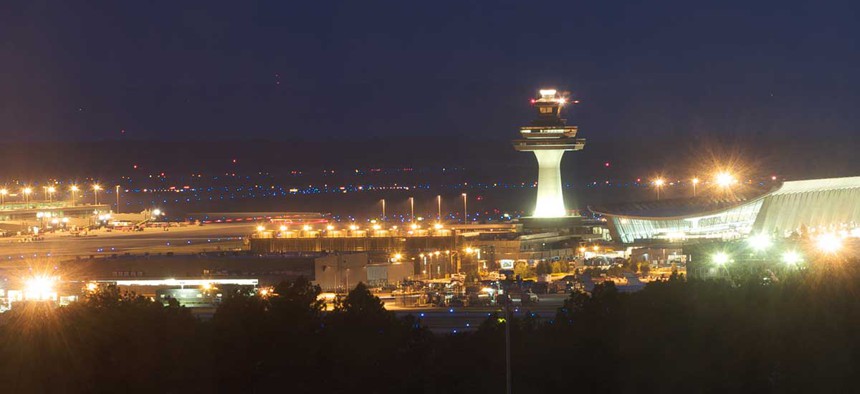
Dulles International Airport is seen lit up at night in 2009. Flickr user dvorak319
The Federal Government Is Changing Tower Lights to Save the Birds
In the battle of pilot warning lights and birds, the Federal Aviation Administration just handed one to our feathered friends.
Flashing lights can be the difference between life and death for bicyclists , for kids getting off school buses , for first responders racing to the site of an crash —so why not the Pied-billed Grebe? Last week, the Federal Aviation Administration continued implementation of a new regulation that will change the steady, red lights that warn aircraft pilots of nearby radio, television, and telephone towers to blinking red ones. Researchers say birds are much less attracted to the flashing illumination—and that the change could save about 7 million avian lives a year.
Of course, even small-seeming federal changes don’t come easy. Groups like the American Bird Conservancy have been calling for lighting shifts since at least the late 1990s , citing estimates that 2 to 4 million songbirds die in collisions with communication towers each year. (A 2012 study put the death toll for American and Canadian birds much higher—at about 6.8 million birds annually.) In 2003, environmental organizations filed suit against the Federal Communications Commission to force them to the study the phenomenon, a case they eventually won .
Then came research: In 2005, federal researchers led by Joelle Gehring, then a conservationist with Central Michigan University, observed Michigan communications towers during peak songbird migration season and suggested bird fatalities would dive by 50 to 71 percent should the towers remove “non-flashing/steady-burning red lights.”

Birds hanging out near an airport in Seattle, Washington. (Flickr/Ingrid Taylar)
Under pressure from wildlife groups, FAA researchers conducted another study in 2012 . Their write-up told a sad tale:
In most instances, the birds will use bright, prominent lights that they can see in the distance as reference points, and fly to them. Unfortunately, the bright, prominent lights they select are often obstruction lights. Small migratory songbirds can become disoriented once they reach an obstruction equipped with these lights, and are unable to determine in which direction to fly to their next destination. As a result, the birds tend to continue to fly around the obstruction in a state of confusion and, in some cases, fly right into the obstruction guy wires. They may also become so exhausted from flying around the tower that they fall to the ground.
Though scientists are still not quite certain why flashing lights don’t attract the same kind of crazy bird activity, the federal researchers recommended the government officially avoid the treacherous lighting pattern. By December 2015, the FAA had released official instructions to switch all new towers to the new, non-bird-destroying lighting scheme. The operators of older towers will have until mid-September 2016 to make the shift.
Birds thanking their lucky (flashing) stars this year include 13 threatened species, according to Audubon, the conservation group . There’s the aforementioned Pied-billed Grebes, but also Yellow Rails, Swainson’s Warblers, and Prairie Warblers. An estimated 2 percent of each of these species are killed each year by collisions with communications towers.

NEXT STORY: Does Performance Matter in Government?






